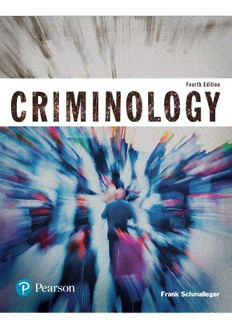
Criminology PDF
Preview Criminology
2 Criminology Fourth Edition Frank Schmalleger Distinguished Professor Emeritus The University of North Carolina at Pembroke 330 Hudson Street, NY, NY 10013 3 Vice President, Portfolio Management: Andrew Gilfillan Portfolio Manager: Gary Bauer Editorial Assistant: Lynda Cramer Senior Vice President, Marketing: David Gessell Field Marketing Manager: Thomas Hayward Product Marketing Manager: Kaylee Carlson Senior Marketing Coordinator: Les Roberts Director, Digital Studio and Content Production: Brian Hyland Managing Producer: Cynthia Zonneveld Content Producer: Holly Shufeldt Manager, Rights Management: Johanna Burke Creative Digital Lead: Mary Siener Managing Producer, Digital Studio: Autumn Benson Content Producer, Digital Studio: Maura Barclay Project Management Support: Susan Hannahs, SPi Global Manufacturing Buyer: Deidra Smith, Higher Ed, RR Donnelley Cover Designer: Melissa Welch, StudioMontage Cover Art: Christian Mueller/Shutterstock Full-Service Management and Composition: iEnergizer Aptara®, Ltd. Full-Service Project Managers: Debbie Ryan and Manas Roy, iEnergizer Aptara®, Ltd. Printer/Bindery: RR Donnelley/Menasha Cover Printer: Lehigh Phoenix Color Text Font: Times LT Pro 10/12 Copyright © 2018, 2016, 2014, 2011 by Pearson Education, Inc. or its affiliates. All rights reserved. Manufactured in the United States of America. This publication is protected by Copyright, and permission should be obtained from the publisher prior to any prohibited reproduction, storage in a retrieval system, or transmission in any form or by any means, electronic, mechanical, photocopying, recording, or likewise. For information regarding permissions, request forms, and the appropriate contacts within the Pearson Education Global Rights and Permissions department, please visit www.pearsoned.com/permissions/. 4 Acknowledgments of third-party content appear on the appropriate page within the text. Unless otherwise indicated herein, any third-party trademarks, logos, or icons that may appear in this work are the property of their respective owners, and any references to third-party trademarks, logos, icons, or other trade dress are for demonstrative or descriptive purposes only. Such references are not intended to imply any sponsorship, endorsement, authorization, or promotion of Pearson's products by the owners of such marks, or any relationship between the owner and Pearson Education, Inc., or its affiliates, authors, licensees, or distributors. Library of Congress Cataloging-in-Publication Data Names: Schmalleger, Frank, author. Title: Criminology / Frank Schmalleger, Distinguished Professor Emeritus, The University of North Carolina at Pembroke. Description: Forth edition. | Boston : Pearson, [2018] | Includes index. Identifiers: LCCN 2016030174 | ISBN 9780134548647 | ISBN 0134548647 Subjects: LCSH: Criminology. Classification: LCC HV6025 .S344 2018 | DDC 364–dc23 LC record available at https://lccn.loc.gov/2016030174 ISBN 10: 0-13-454864-7 ISBN 13: 978-0-13-454864-7 SVE ISBN 10: 0-13-454880-9 ISBN 13: 978-0-13-454880-7 5 Dedication For Ava and Malia 6 Major Theoretical Developments In Criminology Classical School Classical Criminology 1764Cesare Beccaria Deterrence through punishment, free will, social contract 1789Jeremy Bentham Hedonistic calculus, utilitarianism Neoclassical Criminology 1974Robert Martinson Nothing-works doctrine 1975James Q. Wilson Thinking about crime 1986Clarke & Cornish Rational choice 1988Jack Katz Seductions of crime, emotions and crime 1992Clarke & Cornish Situational choice, situational crime prevention Biological and Biosocial Theories Early Positivism 1810 Franz Joseph Gall Phrenology, scientific understanding of crime 1830s Johann Gaspar Spurzheim Brought phrenology to America Criminal Anthropology 1863Cesare Lombroso Atavism, born criminals, criminaloids, Italian School 1913Charles Buckman Goring Challenged Lombroso’s theory 1939Earnest Hooton Environment + low-grade human = crime Criminal Families 1877Richard Dugdale The Juke family 1912Henry Goddard The Kallikak family 1915Arthur Estabrook 7 Constitutional Theories 1925Ernst Kretschmer Somatotyping 1949William Sheldon Body types, behavioral genetics/twins, heritability, human genome Twin studies 1968Karl Christiansen and Sarnoff Mednick Genetic determinism Sociobiology 1975Edward O. Wilson Altruism, territoriality, tribalism, survival of gene pool Biosocial Criminology 1980 Darrell J. Steffensmeier 1997 Anthony Walsh Environmental mediation of genetic influences 1990s Adrian Raine Brain dysfunction 2003 Kevin M. Beaver and Anthony Walsh Biosocial criminology 2010 Thomas Bernard Gender-ratio problem 2010 Kevin M. Beaver, John P. Wright, and Anthony Walsh Evolutionary theory Psychological/Psychiatric Theories Modeling Theory 1890Gabriel Tarde Imitation Albert Bandura Aggression is learned, aggression is rewarded, disengagement, social 1973 cognition theory, modeling Psychoanalytic Criminology 1920s– Sigmund Freud Psychoanalysis, 1930s Id, ego, superego, sublimation 1930s August Aichorn Damaged egos Personality Theory 8 1941Hervey Cleckley Psychopathology, psychopath, sociopath 1964Hans Eysenck Traits, supertraits 1968DSM-II Antisocial personality disorder Behavior Theory 1950s B. F. Skinner Operant 1970s Conditioning, operant behavior, rewards/punishments, stimulus-response Frustration–Aggression Theory 1939J. Dollard Displacement, catharsis Cognitive Theory 1955Jean Piaget Stages of human intellectual development 1969Lawrence Kohlberg Stages of moral development 1970Stanton Samenow and Samuel Yochelson The criminal mindset 1979Roger Shank and Robert Abelson Script theory Crime as Adaptation 1950s John Bowlby Secure attachment, anxious resistant attachment, anxious avoidance attachment 1971 S. M. Halleck Alloplastic adaptation, autoplastic adaptation 1995 Linksy, Bachman, Straus Societal stress, aggression 1998 Donald Andrews and James Bonta Criminogenic needs, criminogenic domains Social Structure Approaches Social Disorganization 1920 Thomas & Znaniecki Displaced immigrants 1920s Park & Burgess Social ecology 1930s Social pathology, concentric zones (Chicago School) 1929 Shaw & McKay Cultural transmission (Chicago School) 1973 Oscar Newman Defensible space 1982 James Q. Wilson & George L. Kelling Broken windows, criminology of place 1987 Rodney Stark Theory of deviant neighborhoods 9 Culture Conflict 1927 Frederic Thrasher Gangs and gang typologies 1938 Thorsten Sellin Conduct norms, primary conflict, secondary conflict 1943 William F. Whyte Subcultures 1955 Albert Cohen Gangs, reaction formation 1957 Sykes & Matza Techniques of neutralization 1958 Walter B. Miller Focal concerns 1960s Cloward & Ohlin Illegitimate opportunity structure, delinquent subcultures 1967 Ferracuti & Wolfgang Violent subcultures Strain Theory 1938Robert Merton Anomie, conformity, innovation, ritualism, retreatism, rebellion 1982Blau & Blau Relative deprivation, frustration, distributive justice 1992Robert Agnew General strain theory 1994Messner & Rosenfeld American Dream Social Process & Social Development Theories Social Learning Theory 1939Edwin Sutherland Differential association 1960Daniel Glaser Differential identification theory 1966Burgess & Akers Differential association-reinforcement Social Control Theory 1950s Walter Reckless Containment theory, inner and outer containment 1969 Travis Hirschi Social bond and self-control: attachment, commitment, belief, involvement 1970s Howard Kaplan Self-degradation 1990 Hirschi & Gottfredson Social bonds and self-control, general theory of crime 1995 Charles Tittle Control-balance, control surplus, control deficit 1995 Per-Olof H. Wikström Situational action theory Labeling Theory 1938Frank Tannenbaum Tagging, dramatization of evil 1951Edwin Lemert Primary deviance, secondary deviance 10
